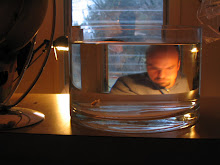
Two nights ago, on a balmy December evening, L. and I walked Cleo up to the Homewood House, the stately villa that was built by the locally important Carroll family in the early 1800s, and that now stands at the middle of the Johns Hopkins campus. The building's a museum now, and it was tricked out, on Monday, in its holiday best: glass-enclosed candles lined the front walk, a wreath colored the door, and a number of volunteers offered brief tours of the interior.
So much space, so much order, so much clarity. One gets the sense, in such preserved spaces, that our wealthier forefathers lived in a world that was not unlike that of Le Corbusier's clean dreams. A bed, a bedpan, a dresser - and no scattered clothes, or dust motes. A central table in the dining room, with a crystalline array of silver - and no half-finished magazines, or misplaced sippy cups, or CD jewel cases. It's as though such people lived in an environment that was simply not yet overwhelmed by the surfeit of things that's now so familiar to all of us: that the harp in the drawing room was significant precisely because it was one of a mere handful of made objects that could be used for entertainment.
Perhaps, perhaps. And images from earlier centuries only confirm such a hunch: the insistently moral interiors in De Hooch's paintings, for instance, suggest that the 17th century, as well, was simply a cleaner, simpler time. But the historian in me wonders, nonetheless: mightn't this have been, to an extent, a curated impression, or an editor's decision? De Hooch worked for clients who wanted to project an air of Calvinist propriety, and no doubt unseemly complexities were thus eliminated in the final painting. Indeed, doesn't something similar happen in the pages of a modern architectural journal like Dwell? We admire the clean lines and immaculate surfaces even as we recognize, simultaneously, that a cleaning crew likely worked to produce such a look, moments before the shoot.
And yet, as we wandered through the Homewood House, we encountered a piece of evidence that suggested that pure, geometric simplicity has in fact always been, and will always be, at hand. In a small chamber a quartet from the Peabody Institute played the final movement of a composition by Haydn. Drawn by the dynamic, energetic sounds, we stepped into the room and took seats in the back, and allowed the music to wash over us. Ascending motifs, competing lines and complementary passages - but all of it arranged, it seemed to me, in strict accordance with a deep, abiding respect for mathematics and ideal symmetry.
The music, I want to say, cut through me. The rougher, more ambiguous contours of the day dissolved; all seemed cleaner, more precise, more obvious. And so, refreshed, we moved back into the rest of the house and its precise, ordered rooms, before leaving, a few minutes later, and driving home. But even when we opened the door to our own house, and entered a more densely populated world of plastic toys and CD jewel cases, Haydn's lesson persisted. Played live or heard in reproduction, the music bears a powerful reminder. Beneath the scrim there are deeper and more elegant tides.




No comments:
Post a Comment